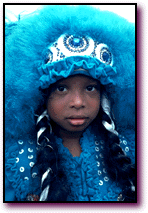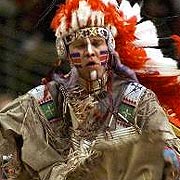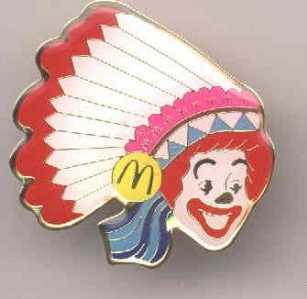Want to Use My Suit? Then Throw Me Something
By Campbell Robertson
He is also one of a number of Indians who have become fed up with seeing their photographs on calendars, posters and expensive prints, without getting anything in return.
Knowing that there are few legal protections for a person who is photographed in public—particularly one who stops and poses every few feet—some Mardi Gras Indians have begun filing for copyright protection for their suits, which account for thousands of dollars in glass beads, rhinestones, feathers and velvet, and hundreds of hours of late-night sewing.
The "honoring people by imitating them badly" rationale doesn't work in any other context, so why should it work here? Answer: It doesn't.
Below: "Last Friday, at a St. Joseph's Night parade in New Orleans, Santana Montana of the Monogram Hunters tribe went to greet his father, David Montana of the Yellow Pocahontas tribe." (Chris Bickford for The New York Times)

Rob Capriccioso offers some background on these faux "Indians":
Mardi Gras Indians get treated like real Indians; don’t like it
The fake Indians use names like the “Monogram Hunters tribe” and the “Yellow Pocahontas tribe.” They wear feathers on their heads, call themselves chiefs, and have a grand tribal council.
As Indianz.com writes, “Many costumes contain elements of traditional Indian regalia that could be found at powwows across the country.
“But the Mardi Gras ‘Indians’ say they are the ones being exploited. Their likenesses, and costumes, are being used in photographs without their consent and they usually don’t have any recourse.”
Capriccioso hits the point home:
The Mardi Gras stereotypers are upset because people are (mis)appropriating their costumes. Yet they're doing the same thing: (mis)appropriating Indian lore. How would they respond if a real Indian said the same thing to them that they're saying to the photographers? "Oh, well...that's different. Our exploitation is sincere and theirs isn't. We don't just admire real Indians, we really admire them."
Their usual rationale is that Indians helped their ancestors, so their homage is justified. But this isn't much different from the excuses used by the Cleveland Indians or Washington Redskins. "An Indian player or coach helped our team, so that justifies our
For more on the subject, see Mardi Gras Indian Stereotypes and Phony Indians "Honor" Real Indians.
Below: Which "homages" are sincere and flattering and which aren't?





2 comments:
To drive the point home further, "Mardis Gras Indians" are stealing more than just our traditional outfits, they're stealing our Pow Wow Grand Entries, to celebrate hedonistic behavior that no ethnic group would ever find a reverent to them, had their cultural inheritance had been taken instead of our's.
The history of the "Mardi Gras Indians", as told to me by several individuals over many different years, began with the collapse of the French economy/power structure. This lead to French plantation owners in the Louisana area to free their African slaves, as the plantation owners couldn't afford to feed and clothe the slaves, anymore.
Once the African slaves had been freed, they flocked to the regional Native communities, where they "learned a new form of music, dance, and dress". Arguably, what the Africans were introduced was in fact a Pow Wow. After a few months with the Native communities, the Africans moved towards the cities of New Orleans and Mobile, bringing with them this "new music, dance, and dressing". As was told to me by many different people, as I've said before, these Native cultural appropriations are what became known as the earliest forms of Blues music, Jazz music, Gospel music, and the New Orleans/Mobile style of celebrating Mardis Gras.
I do find it overly ironic that these "Mardis Gras Indians" are trying to sue for copyright protection... maybe we should sue them and basically the entire American music industry too, enit?
Today is super sunday in new orleans and I stumbled across this open ed piece. Please delve deeper into the history and rationale for what is known as "masking" as someone racial ties to both communities in the article it took my own research and questions to get a better answer an it is not as simple as cultural appropriation or tribute.
Post a Comment